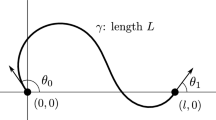Abstract
The Euler problem on optimal configurations of elastic rod in the plane with fixed endpoints and tangents at the endpoints is considered. The global structure of the exponential mapping that parameterises extremal trajectories is described. It is proved that open domains cut out by the Maxwell strata in the preimage and image of the exponential mapping are mapped diffeomorphically. As a consequence, computation of globally optimal elasticae with given boundary conditions is reduced to solving systems of algebraic equations having unique solutions in the open domains. For certain special boundary conditions, optimal elasticae are presented.
Similar content being viewed by others
References
Agrachev AA, Barilari D. Sub-Riemannian structures on 3D Lie groups. J Dynam Control Syst. 2012;18(1):21–44.
Agrachev AA, Sachkov YuL. Geometric control theory. Moscow: Fizmatlit; 2004. English transl. Control theory from the geometric view- point. 2004.
Ardentov AA, Sachkov YuL. Extremal trajectories in nilpotent sub-Riemannian problem on Engel group. Sbornik Mathematics 2011;202(11):31–54. English translation: Sbornik Mathematics 2011;202(11):1593–1616.
Ardentov AA, Sachkov YuL. Solution of Euler’s elastic problem. Avtomatika i Telemekhanika 2009;4:78–88. (in Russian, English translation in automation and remote control).
Euler L. Methodus inveniendi lineas curvas maximi minimive proprietate gaudentes, sive Solutio problematis isoperimitrici latissimo sensu accepti. Lausanne: 1744.
Krantz SG, Parks HR. The implicit function theorem: history theory, and applications. Boston: Birkauser; 2001.
Love AEH. A treatise on the mathematical theory of elasticity, 4th ed. New York: Dover; 1927.
Mashtakov A, Sachkov YuL. Extremal trajectories and Maxwell points in the plate-ball problem. Sbornik Mathematics 2011;202(9):97–120.
Sachkov YuL. Complete description of the Maxwell strata in the generalized Dido problem (in Russian). Matem Sbornik 2006;197(6):111–160. English translation in: Sbornik Mathematics 2006;197(6):901–50.
Sachkov YuL. Maxwell strata in the Euler elastic problem. J Dynam Control Syst. 2008;14(2):169–234.
Sachkov YuL. Conjugate points in Euler’s elastic problem. J Dynam Control Syst. 2008;14(3):409–439.
Sachkov YuL. Closed Euler elasticae. Proc Steklov Inst Math. 2012;278:218–232.
Whittaker ET, Watson GN. A course of modern analysis. An introduction to the general theory of infinite processes and of analytic functions; with an account of principal transcendental functions. Cambridge: Cambridge University Press; 1996.
Wolfram S. Mathematica: a system for doing mathematics by computer. Reading: Addison-Wesley; 1991.
Author information
Authors and Affiliations
Corresponding author
Rights and permissions
About this article
Cite this article
Sachkov, Y.L., Sachkova, E.F. Exponential Mapping in Euler’s Elastic Problem. J Dyn Control Syst 20, 443–464 (2014). https://doi.org/10.1007/s10883-014-9211-1
Received:
Revised:
Published:
Issue Date:
DOI: https://doi.org/10.1007/s10883-014-9211-1



